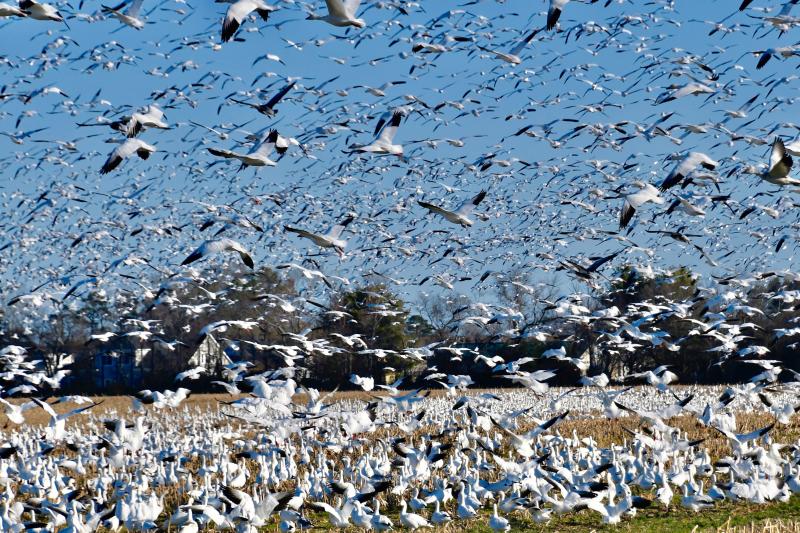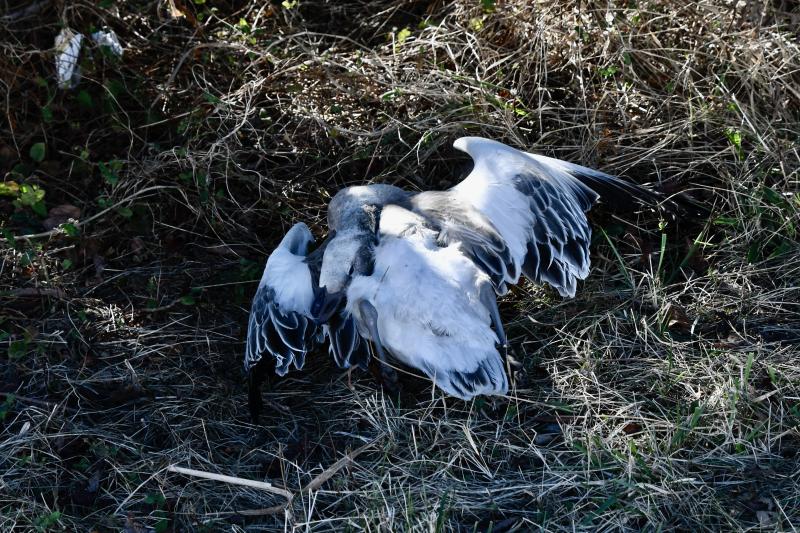Snow geese dying from bird flu
Dead snow geese falling from the sky. It’s not a plot for a sci-fi movie; it’s actually happening in coastal areas of Sussex County.
State officials have found dead or dying snow geese infected with avian influenza, aka bird flu. It’s normally associated with poultry, but wild birds such as turkeys, geese, quail, vultures, and other shorebirds and waterfowl are susceptible to the disease. State officials estimate there are about 45,000 snow geese in Kent and Sussex counties.
The affected geese have tested presumptive positive for H5 avian influenza. Presumptive positive is a term used in the early days of a pandemic by the Centers for Disease Control.
At least six dead geese were found in Broadkill Beach and even one in a backyard in Lewes. As of Dec. 30, Department of Natural Resources and Environmental officials had reported more than 40 dead geese, including snow geese found at Prime Hook Beach. A total count of sick birds cannot be confirmed because wild birds often get sick and die where the public cannot see them. Snow geese fly long distances, which means infected geese may die in other locations and transmit the virus to other birds, including poultry, officials said.
According to DNREC officials, there are no human health concerns from the strains of avian influenza that have been reported in the United States.
Avian influenza is a serious disease concern for poultry producers and animal health officials. While influenza strains in birds, just as in people, vary considerably in severity, some influenza viruses can be devastating to domestic poultry, officials said.
Avian influenza can be transmitted by wild birds or waterfowl. Poultry farmers take biosecurity steps every day to keep their flocks healthy and safe. The virus can be transmitted on shoes, vehicles and equipment, which is why officials ask everyone with poultry to take the proper precautions and use strict biosecurity protocols.
Proper response is important
Anyone encountering sick or dead wild birds on private or public property is asked to report their findings immediately. They may call the DNREC Wildlife Section at 302-739-9912 from 8 a.m. to 4:30 p.m. Monday through Friday. After hours, on weekends and holidays, report sightings through the DNREC Division of Fish and Wildlife’s sick and injured wildlife reporting form at tinyurl.com/ycx4v4fm.
Farmers should notify Delaware Department of Agriculture if they find dead or sick wild birds on their farm by emailing poultry.health@delaware.gov.
If a resident finds a dead bird on their property, they should wear proper personal protective equipment, including gloves, a mask and safety glasses, to dispose of it. They should double-bag each dead bird found, zip-tie the bag and put it in the trash bin for pickup and disposal at a Delaware Solid Waste Authority landfill. Afterward, they should carefully remove and dispose of all protective wear in the dedicated trash, and always wash their hands.
DNREC also reminds hunters to be cautious when handling their harvests of duck and geese in the field as the waterfowl season continues in Delaware.
Snow geese facts
Each winter, large flocks of snow geese migrate to the local area from their Arctic breeding grounds – most from Greenland – to escape the bitter winter. Most return north in the spring.
They spend daylight hours feeding on area farm fields, and nights in marshes and waters along the Delaware Bay coastline.
Here are some facts about snow geese:
• There are an estimated 5 million of them, which is a 300 percent increase over the past 40 years, although scientists say the population is leveling off
• A snow goose can fly 40 mph and up to 70 mph with a strong tailwind
• With good weather and winds, a snow goose can cover up to 1,500 miles in one day
• Most migrations range from 2,000 to 3,000 miles
• Snow geese can sleep while floating on the water.

















































